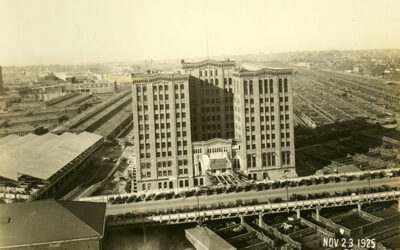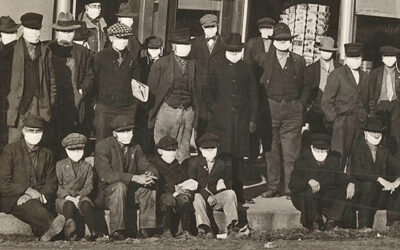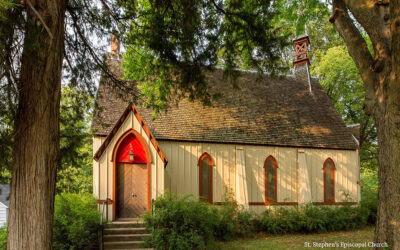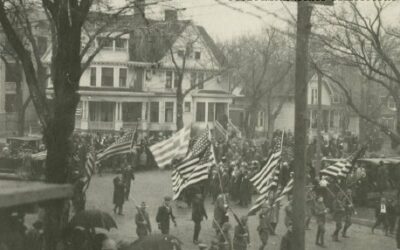Want more at-home conservation resources? We’ve got you covered.
October is Archives Month
Your family’s heirloom photographs are special treasures. Taking proper care of them is an important responsibility. Here are a few things to watch for and suggestions on how to protect your family photographs.
1. Temperature and Humidity
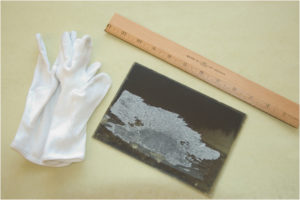
- Relative humidity is the amount of water in the air. It is the single most important environmental factor in the preservation of your family photographs. The ideal RH in an archive is 40%. This may be difficult to achieve in your home. Just remember, high levels (50%-100%) cause oxidation, fading, and spread of fungus and low levels (0-30%) can cause photos to become brittle and shrink unevenly. The best environment for your photographs avoids extreme fluctuations between high and low humidity levels.
- Temperature is also a factor in preserving your heirloom photographs. Deterioration is the chemical breakdown of the photograph, and heat increases chemical reactions. The ideal temperature for archives is 60-65°F, but anything below 65°F, is no longer comfortable for people to work in for long periods of time. Keep temperatures as low as possible without raising RH and causing condensation when moved to a warmer environment.
- What to do: It is important to create a stable environment. Avoid places without temperature control such as basements, attics, garages, barns, etc. Consistent temperature is important and storage places such as under beds and in interior closets are good options. Using proper storage and housing will also help insulate photographs from fluctuations in temperature and humidity.
2. Light
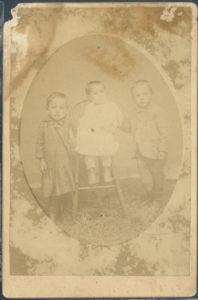
- Light is just plain BAD. It causes images to fade and yellow. Damage caused by light is permanent. Ultraviolet (UV) light causes the most damage. While UV filters do offer some protection, they do not eliminate light damage. Some types of images are particularly light-sensitive such as albumen prints, cyanotypes, and especially color images.
- What to do: Display copies whenever possible. Scanning or photocopying cause little harm. Continued light exposure & handling cause much more damage. It is best for original photographs to be kept in the dark.
- If you do display an original print, remember that the damage is permanent. Here are a few precautions you can take to help protect original photographs on display. Avoid direct sunlight and choose glass with UV protection. Select archival quality frame and mats. Also, monitor any fading that does occur.
3. Pests & Other Bad Things

- Insects, rodents and mold. Organic materials such as the gelatin, cellulose, and paper that make up photographs are tasty meals for insects, rodents, and mold. An infestation or outbreak is often the result of poor storage conditions. Insects and mold breed in moist, dark spaces. Monitor your photograph collection for things that will eat your collection like rodents, mold, and insects such as silverfish, firebrats, German cockroaches, furniture beetles, and termites. Also, you should watch out for things that leave behind messes. Rodents and insects such as cockroaches, flies, spiders, wasps, etc. are often messy culprits.
- What to do: Your best defense against pests is good housekeeping. Prevention is the best protection. Improve your storage conditions and keep the area clean. Monitor your collection and be on the lookout for tell-tale signs. If you think you have a problem, handle your photographs with care and protect yourself. Use sticky traps to identify species of insect. When in doubt, contact an expert, like those at our Gerald R. Ford Conservation Center.
4. Poor Storage

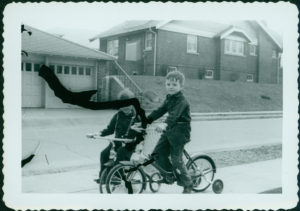
- Create a safe, stable environment. You should choose storage locations that offer consistent temperature & humidity that are away from pests. Protect your photos from water damage. Whether flooding is caused by nature, broken pipes, leaking water heaters, or overflowing washing machines, water from any source can cause severe damage. So, pay close attention to storage locations. Impurities in the air can also speed up deterioration. Gases that are given off from wood, cardboard, newspapers, and some types of negatives can cause damage like fading, discoloration, and embrittlement. Solid particulates like dust, pollen, and soot can cause scratches and damage to photographic surfaces.
- What to do: Choose your storage location wisely. Look for water sources. Avoid fireplaces and cedar chests. Remove old newspapers. Store in proper photograph storage that provides support and protection. Good photographic storage will improve organization and aid in disaster recovery. Use only materials that have passed the Photographic Activity Test (PAT), that meet or exceed national standards and will not harm your photographs. This is not the same as “archival.” There is no standard or legal definition for the word archival. Manufacturers can use the word in advertising regardless of the quality of their product. PAT is the best indicator that has been manufactured to strict standards and are acid-free, lignin-free and unbuffered. When selecting an enclosure, choose the size closest to what you are storing. If it is too tight, it could damage the photograph when removed. And if it is too loose, the photograph could slide around damaging corners and scratching the emulsion.
- Paper vs. Plastic Enclosures. Both paper and plastic enclosures offer protection to your photographs. Here are a few tips to consider when choosing. Plastic might be a better choice over paper for damaged, weak, thin, or brittle photographs. Also, plastic is good for prints that are often handled or looked at. Paper enclosures are a better choice for nitrate or acetate negatives that need to off-gas. Poorly processed prints should also be stored in paper.
- Paper Enclosures: The enclosures should be chemically stable, smooth, non-abrasive and pass the PAT test. Typically, unbuffered paper is recommended for all photos, but new studies from the Image Permanence Institute show that buffered paper is also okay. Do not use glassine or magnetic albums. If you have photos in these magnetic photo albums, remove them immediately.
- Plastic Enclosures: These enclosures should be chemically inert with no surface coatings and pass the PAT test. The main types include polyester, polypropylene and polyethylene.
5. You
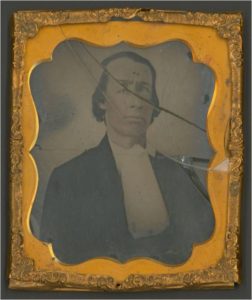

- Improper handling causes the most harm. Even in the most ideal storage conditions, photos can still be damaged. Photographs are easily bent, torn, and cracked. Fingerprints damage emulsion and attract insects.
- What to Do: Wear white cotton or latex/nitrile gloves. When picking up a photograph, use both hands and never pick up or hold photographs by the corners. Support the image if you turn it over. For very fragile items, use paper or mat board for extra support.
- Use a soft brush to gently remove dust particles.
- What NOT to Do: Do not attempt to clean or repair heirloom photographs yourself or allow anyone (even commercial photographers) not trained in photographic conservation to “restore” or repair your photographs. Consult a professional photograph conservator.
- Good intentions often cause more damage. Tears are best left unmended. Do NOT use tape, glue, rubber cement, staples, thumbtacks or anything else to “repair” your photographs. Torn photos should be placed in clear plastic sleeves.
- Also, do not use rubber bands or paper clips to bind photographs together.
- Labeling Photographs: Always label your photographs! Use proper names and avoid nicknames or titles (i.e.: John Smith and not “my father’s uncle”). Do not press too hard. Write on the back of the photo along the edge. Never write on the front.
- Use a pencil! Pens can bleed through the paper and smear, especially during a disaster. We like woodless graphite pencils that can be found at most craft and art supply stores in either soft or extra soft. These pencils will even write on modern, resin-coated photographs.

